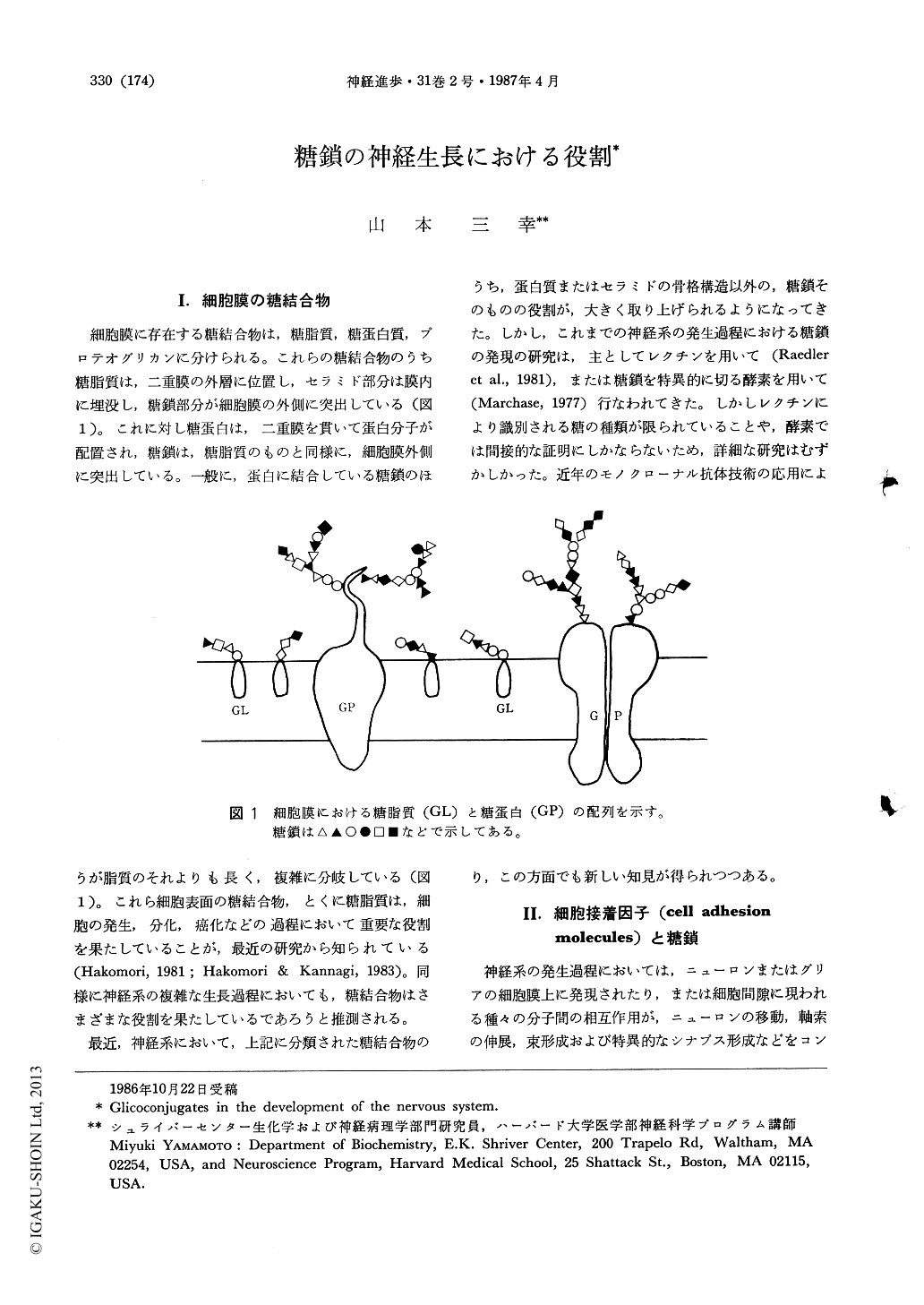Japanese
English
- 有料閲覧
- Abstract 文献概要
- 1ページ目 Look Inside
I.細胞膜の糖結合物
細胞膜に存在する糖結合物は,糖脂質,糖蛋白質,プロテオグリカンに分けられる。これらの糖結合物のうち糖脂質は,二重膜の外層に位置し,セラミド部分は膜内に埋没し,糖鎖部分が細胞膜の外側に突出している(図1)。これに対し糖蛋白は,二重膜を貫いて蛋白分子が配置され,糖鎖は,糖脂質のものと同様に,細胞膜外側に突出している。一般に,蛋白に結合している糖鎖のほうが脂質のそれよりも長く,複雑に分岐している(図1)。これら細胞表面の糖結合物,とくに糖脂質は,細胞の発生,分化,癌化などの過程において重要な役割を果たしていることが,最近の研究から知られている(Hakomori,1981;Hakomori & Kannagi,1983)。同様に神経系の複雑な生長過程においても,糖結合物はさまざまな役割を果たしているであろうと推測される。
最近,神経系において,上記に分類された糖結合物のうち,蛋白質またはセラミドの骨格構造以外の,糖鎖そのものの役割が,大きく取り上げられるようになってきた。しかし,これまでの神経系の発生過程における糖鎖の発現の研究は,主としてレクチンを用いて(Raedler et al.,1981),または糖鎖を特異的に切る酵素を用いて(Marchase,1977)行なわれてきた。
The nervous system in higher vertebrates has a very complex but very specific organization. To achieve such a highly specific structure, it is necessary that events which occur during development should be precisely arranged temporalily and spatially. A proposed mechanism is that particular molecules are expressed on the surface of particular subsets of cells or along particular pathways where subsets of axons are targeted during certain developmental stages.
Detailed chemical knowledges of a large number of glycosphingolipids and glycoprotein has become available in the last few years and a body of evidence has accumulated which indicates that glycoconjugates are associated with cell-cell interaction and differentiation in various tissues. In this review, several examples of glycoconjugates are described, which are expressed in the developing or matured vertebrate nervous system in temporally and spatially specific manner. HNK-1 antigen (glucuronic acid and sulfate containing carbohydrate) is conjugated with broad spectrum of molecules including MAG, NCAM and Ll. The function of HNK-1 carbohydrate chain appears to be related to neuron-astrocyte and astrocyte-astrocyte adhesion. Although, this HNK-1 epitope is distributed widely in embryonic and matured nervous system, some other carbohydrates show more specific distribution pattern. Examples are globoseries carbohydrates; SSEA3 and SSEA4, and lactoseries carbohydrate; A5 and LA4 antigens. These four different carbohydrates are expressed in functionally different subpopulation of rat dorsal root ganglion cells, their axons and their terminals in the spinal cord. This result indicates that cell surface carbohydrate can be a signal for the recognition between functional subsets of dorsal root ganglion cells and their target neurons in the spinal cord.

Copyright © 1987, Igaku-Shoin Ltd. All rights reserved.


